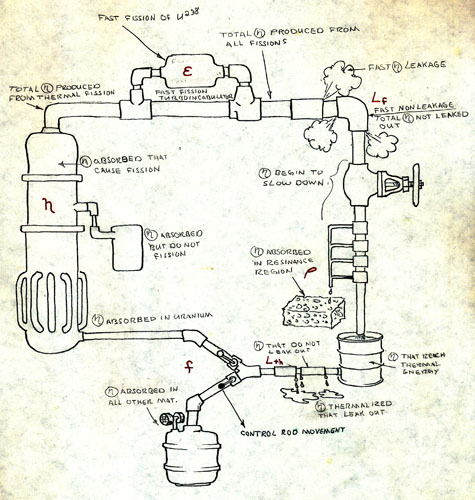Does anyone remember this moniker? Here is a clue, the moniker was introduced when we all attended Nuke school and the learned about the operation of a nuclear reactor during Reactor Principles. This led to the discussion of the sources of the thermal neutrons which allow nuclear plants to become critical and generate energy through the splitting of Uranium.
I’ll let the secret out, Ever Little Person Loved the Funny Navy stands the six factors of neutron multiplication. Do you remember what these are? For those of us who may not remember since it has been many years since nuke school the factors are:
1. The fast fission factor symbolized by the Greek symbol, e
2. The fast non-leakage probability which is symbolized by Lf
3. The resonance escape probability represented by p
4. The thermal non-leakage probability, Lt
5. The thermal utilization factor, f
6. The thermal fission factor or reproduction factor characterized by the letter n.
These six factors give the highlights of the numbers of neutrons available in a nuclear reactor.
To look at this from the vantage of a neutron the journey to causing fission event begins with a fast (with energy greater than thermal energies) neutron that has been generated by the fission of a uranium atom bombarded with a neutron. Either one of two things can occur; it can leak from out of the reactor or not. Neutrons which leak out are no good to us. Therefore the probability of neutrons which do not leak when while will be the neutrons which are still available to cause fissions. This is defined as Lf. From there these neutrons can do one of two things either slow to energies closer to the molecules around them or be absorbed. As our goal is to get thermal neutrons we are interested in the likelihood of neutrons that are not absorbed and are slowed to thermal energies. This is identified as p the resonance escape probability. Remember the fast neutrons which started this discussion? They can cause fission events as well. The odds of this occurrence are called e the probability of fission from fast neutrons. Returning back to our thermal electrons in the same fashion as the fast electrons they can leak from out of the reactor or not leak. Those which remain are known as Lt which is the probability of thermal neutrons not to leak, and thus be available to create fission events. At this point our thermal neutron can either be either absorbed in some materials or absorbed in our fuel. The likelihood the thermal neutron is absorbed in the fuel is referred to as f, the thermal utilization factor. Finally every neutron absorbed in the fuel does not necessarily cause a fission event. Therefore the probability of a neutron causing a fission event and is not captured once is absorbed by the fuel is defined as n.
With that said who cares? Of course, the nerdy nuke in everyone who has ever attended naval nuclear power school, some of which read this posting the very end…...
Image courtesy of http://www.jensen-graphics.com/Neutron.html
This the blog home of www.exnavynuke.com. This is the official blog of all Ex United States Navy Nuclear trained sailors. This is intended to be a sounding board for all nukes past present and future.
Subscribe to:
Post Comments (Atom)

1 comment:
That's bad, but not as bad as the primary chemistry mneumonic. To wit "15 very very gross cunts pull hymie's tiny crank daily in D C".
Post a Comment